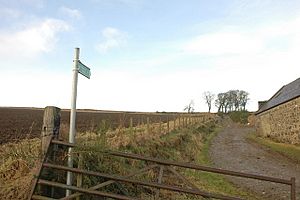Ythan Wells facts for kids
Quick facts for kids Glenmailen, Ythan Wells |
|
|---|---|
| Aberdeenshire, Scotland, UK | |
|
Location in Scotland
|
|
| Coordinates | 57°25′57″N 2°34′34″W / 57.432432°N 2.576164°W |
Ythan Wells, also called Glenmailen, is an ancient site in Aberdeenshire, Scotland. It was once a large Roman military camp. You can find it near the Glenmellan farm, about 2.1 kilometers east of the village of Ythanwells. This important historical place is now protected as a scheduled monument.
Archaeologists have found signs of two different Roman camps here. The first camp was very big, covering about 42 hectares (that's like 100 football fields!). It was discovered way back in 1785. Later, in 1968, a smaller camp was found. This one was about 13 hectares and partly overlapped the first. The smaller camp is older. Experts believe it was built during the time of Agricola, a famous Roman general.
The site is special because it's at the very start of the River Ythan. Many natural springs here provided fresh, clean water. This was very handy for the large Roman army camps that were set up in the first few centuries AD.
The Roman army built a line of huge forts across Scotland. These included places like Ardoch, Strageath, Inchtuthil, Battledykes, Stracathro, and Raedykes. They used a route called the Elsick Mounth to reach camps like Normandykes, and then moved further north to places like Deers Den and Glenmailen (Ythan Wells).
Why Ythan Wells is Important
Ythan Wells is a really important site for understanding the Roman army. It helps experts learn how Roman camps were built and used. They can see how the design of these camps changed over time.
This site also helps us understand how Roman camps were spread out. It shows how they connected with other ancient places in the landscape. By studying Ythan Wells, we can learn about the daily lives of Roman soldiers. It also gives us clues about how the Roman army affected the local Iron Age communities and the land.
Ythan Wells is extra special because it has two camps built on top of each other. They are different sizes and types. It's also one of the most northern Roman camps found in Scotland. The larger camp, Ythan Wells I, seems to be part of a group of very big camps in northeast Scotland.
Part of the old camp's defenses, like earthworks, can still be seen today. This means there's a good chance that important items and natural remains are still buried there. People started writing about Ythan Wells I in the 1700s, which adds to our knowledge of this camp. If this site were ever damaged, we would lose a lot of valuable information about Roman camps and their military plans.
See also
 In Spanish: Ythan Wells para niños
In Spanish: Ythan Wells para niños



